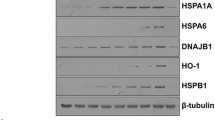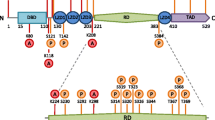Abstract
Alzheimer’s disease, Parkinson’s disease and amyotrophic lateral sclerosis (ALS) are ‘protein misfolding disorders’ of the mature nervous system that are characterized by the accumulation of protein aggregates and selective cell loss. Different brain regions are impacted, with Alzheimer’s affecting cells in the cerebral cortex, Parkinson’s targeting dopaminergic cells in the substantia nigra and ALS causing degeneration of cells in the spinal cord. These diseases differ widely in frequency in the human population. Alzheimer’s is more frequent than Parkinson’s and ALS. Heat shock proteins (Hsps) are ‘protein repair agents’ that provide a line of defense against misfolded, aggregation-prone proteins. We have suggested that differing levels of constitutively expressed Hsps (Hsc70 and Hsp27) in neural cell populations confer a variable buffering capacity against ‘protein misfolding disorders’ that correlates with the relative frequencies of these neurodegenerative diseases. The high relative frequency of Alzheimer’s may due to low levels of Hsc70 and Hsp27 in affected cell populations that results in a reduced defense capacity against protein misfolding. Here, we demonstrate that celastrol, but not classical heat shock treatment, is effective in inducing a set of neuroprotective Hsps in cultures derived from cerebral cortices, including Hsp70, Hsp27 and Hsp32. This set of Hsps is induced by celastrol at ‘days in vitro’ (DIV) 13 when cultured cortical cells reached maturity. The inducibility of a set of neuroprotective Hsps in mature cortical cultures at DIV13 suggests that celastrol is a potential agent to counter Alzheimer’s disease, a neurodegenerative ‘protein misfolding disorder’ of the adult brain that targets cells in the cerebral cortex.




Similar content being viewed by others
Abbreviations
- ALS:
-
Amyotrophic lateral sclerosis
- DIV:
-
Days in vitro
References
Abbott A (2002) Neurologists strike gold in drug screen effort. Nature 417:109
Asea AA, Brown IR (eds) (2008) Heat shock proteins and the brain: implications for neurodegenerative diseases and neuroprotection. Springer Science, New York
Barber SC, Shaw PJ (2010) Oxidative stress in ALS: key role in motor neuron injury and therapeutic target. Free Radic Biol Med 48:629–641
Brocchieri L, Conway de Macario E, Macario AJ (2008) Hsp70 genes in the human genome: conservation and differentiation patterns predict a wide array of overlapping and specialized functions. BMC Evol Biol 8:19
Brown IR (2007) Heat shock proteins and protection of the nervous system. Ann N Y Acad Sci 1113:147–158
Brown IR (2008) Heat shock proteins at the synapse: implications for functional protection of the nervous system. In: Asea AAA, Brown IR (eds) Heat shock proteins and the brain: implications for neurodegenerative diseases and neuroprotection. Springer Science, New York, pp 239–254
Brown IR, Rush SJ (1999) Cellular localization of the heat shock transcription factors HSF1 and HSF2 in the rat brain during postnatal development and following hyperthermia. Brain Res 821:333–340
Bruijn LI, Miller TM, Cleveland DW (2004) Unraveling the mechanisms involved in motor neuron degeneration in ALS. Annu Rev Neurosci 27:723–749
Calabrese V, Cornelius C, Mancuso C, Lentile R, Stella AM, Butterfield DA (2010) Redox homeostasis and cellular stress response in aging and neurodegeneration. Meth Mol Biol 610:285–308
Chen S, Brown IR (2007) Neuronal expression of constitutive heat shock proteins: implications for neurodegenerative diseases. Cell Stress Chaperon 12:51–58
Chow AM, Brown IR (2007) Induction of heat shock proteins in differentiated human and rodent neurons by celastrol. Cell Stress Chaperon 12:237–244
Chow AM, Mok P, Xiao D, Khalouei S, Brown IR (2010) Heteromeric complexes of heat shock protein 70 (HSP70) family members, including Hsp70B’, in differentiated human neuronal cells. Cell Stress Chaperon 15:545–553
Choy MS, Chen MJ, Manikandan J, Peng ZF, Jenner AM, Melendez AJ, Cheung NS (2011) Up-regulation of endoplasmic reticulum stress-related genes during the early phase of treatment of cultured cortical neurons by the proteasomal inhibitor lactacystin. J Cell Physiol 226:494–510
Daugaard M, Rohde M, Jaattela M (2007) The heat shock protein 70 family: Highly homologous proteins with overlapping and distinct functions. FEBS Lett 581:3702–3710
Duyckaerts C, Delatour B, Potier MC (2009) Classification and basic pathology of Alzheimer disease. Acta Neuropathol 118:5–36
Forman MS, Trojanowski JQ, Lee VM (2004) Neurodegenerative diseases: a decade of discoveries paves the way for therapeutic breakthroughs. Nat Med 10:1055–1063
Gozzelino R, Jeney V, Soares MP (2010) Mechanisms of cell protection by heme oxygenase-1. Annu Rev Pharmacol Toxicol 50:323–354
Grochot-Przeczek A, Dulak J, Jozkowicz A (2012) Haem oxygenase-1: non-canonical roles in physiology and pathology. Clin Sci (Lond) 122:93–103
Guzman-Beltran S, Espada S, Orozco-Ibarra M, Pedraza-Chaverri J, Cuadrado A (2008) Nordihydroguaiaretic acid activates the antioxidant pathway Nrf2/HO-1 and protects cerebellar granule neurons against oxidative stress. Neurosci Lett 447:167–171
Haass C, Selkoe DJ (2007) Soluble protein oligomers in neurodegeneration: lessons from the Alzheimer’s amyloid beta-peptide. Nat Rev Mol Cell Biol 8:101–112
Heemskerk J, Tobin AJ, Bain LJ (2002) Teaching old drugs new tricks. Meeting of the neurodegeneration drug screening consortium, 7–8 April 2002, Washington, DC, USA. Trends Neurosci 25:494–496
Hong Z, Zhang QY, Liu J, Wang ZQ, Zhang Y, Xiao Q, Lu J, Zhou HY, Chen SD (2009) Phosphoproteome study reveals Hsp27 as a novel signaling molecule involved in GDNF-induced neurite outgrowth. J Proteome Res 8:2768–2787
Kabani M, Martineau CN (2008) Multiple hsp70 isoforms in the eukaryotic cytosol: mere redundancy or functional specificity? Curr Genom 9:338–348
Kim HJ, Joo HJ, Kim YH, Ahn S, Chang J, Hwang KB, Lee DH, Lee KJ (2011) Systemic analysis of heat shock response induced by heat shock and a proteasome inhibitor MG132. PLoS One 6:e20252
King M, Nafar F, Clarke J, Mearow K (2009) The small heat shock protein Hsp27 protects cortical neurons against the toxic effects of beta-amyloid peptide. J Neurosci Res 87:3161–3175
Lesuisse C, Martin LJ (2002) Long-term culture of mouse cortical neurons as a model for neuronal development, aging, and death. J Neurobiol 51:9–23
Li Q, Li J, Zhang L, Wang B, Xiong L (2007) Preconditioning with hyperbaric oxygen induces tolerance against oxidative injury via increased expression of heme oxygenase-1 in primary cultured spinal cord neurons. Life Sci 80:1087–1093
Lok J, Leung W, Murphy S, Butler W, Noviski N, Lo EH (2011) Intracranial hemorrhage: mechanisms of secondary brain injury. Acta Neurochir Suppl 111:63–69
Martin JB (1999) Molecular basis of the neurodegenerative disorders. N Engl J Med 340:1970–1980
Muchowski PJ, Wacker JL (2005) Modulation of neurodegeneration by molecular chaperones. Nat Rev Neurosci 6:11–22
Neef DW, Jaeger AM, Thiele DJ (2011) Heat shock transcription factor 1 as a therapeutic target in neurodegenerative diseases. Nat Rev Drug Discov 10:930–944
Parent M, Parent A (2010) Substantia nigra and Parkinson’s disease: a brief history of their long and intimate relationship. Can J Neurol Sci 37:313–319
Paris D, Ganey NJ, Laporte V, Patel NS, Beaulieu-Abdelahad D, Bachmeier C, March A, Ait-Ghezala G, Mullan MJ (2010) Reduction of beta-amyloid pathology by celastrol in a transgenic mouse model of Alzheimer’s disease. J Neuroinflammation 7:17
Peterson GL (1977) A simplification of the protein assay method of Lowry et al. which is more generally applicable. Anal Biochem 83:346–356
Pinna GF, Fiorucci M, Reimund JM, Taquet N, Arondel Y, Muller CD (2004) Celastrol inhibits pro-inflammatory cytokine secretion in Crohn’s disease biopsies. Biochem Biophys Res Commun 322:778–786
Pramanik D, Dey SG (2011) Active site environment of heme-bound amyloid beta peptide associated with Alzheimer’s disease. J Am Chem Soc 133:81–87
Read DE, Gorman AM (2009) Heat shock protein 27 in neuronal survival and neurite outgrowth. Biochem Biophys Res Commun 382:6–8
Satoh T, Baba M, Nakatsuka D, Ishikawa Y, Aburatani H, Furuta K, Ishikawa T, Hatanaka H, Suzuki M, Watanabe Y (2003) Role of heme oxygenase-1 protein in the neuroprotective effects of cyclopentenone prostaglandin derivatives under oxidative stress. Eur J Neurosci 17:2249–2255
Scapagnini G, Vasto S, Abraham NG, Caruso C, Zella D, Fabio G (2011) Modulation of Nrf2/ARE pathway by food polyphenols: a nutritional neuroprotective strategy for cognitive and neurodegenerative disorders. Mol Neurobiol 44:192–201
Schapira AH, Olanow CW (2004) Neuroprotection in Parkinson disease: mysteries, myths, and misconceptions. JAMA 291:358–364
Selkoe DJ (2003) Folding proteins in fatal ways. Nature 426:900–904
Selkoe DJ (2004) Cell biology of protein misfolding: the examples of Alzheimer’s and Parkinson’s diseases. Nat Cell Biol 6:1054–1061
Stranahan AM, Mattson MP (2010) Selective vulnerability of neurons in layer II of the entorhinal cortex during aging and Alzheimer’s disease. Neural Plast 2010:108190
Tao X, Younger J, Fan FZ, Wang B, Lipsky PE (2002) Benefit of an extract of Tripterygium wilfordii Hook F in patients with rheumatoid arthritis: a double-blind, placebo-controlled study. Arthritis Rheum 46:1735–1743
Tenhunen R, Marver HS, Schmid R (1969) The enzymatic conversion of hemoglobin to bilirubin. Trans Assoc Am Phys 82:363–371
Toth ME, Gonda S, Vigh L, Santha M (2010) Neuroprotective effect of small heat shock protein, Hsp27, after acute and chronic alcohol administration. Cell Stress Chaperon 15:807–817
Westerheide SD, Bosman JD, Mbadugha BN, Kawahara TL, Matsumoto G, Kim S, Gu W, Devlin JP, Silverman RB, Morimoto RI (2004) Celastrols as inducers of the heat shock response and cytoprotection. J Biol Chem 279:56053–56060
Williams KL, Mearow KM (2011) Phosphorylation status of heat shock protein 27 influences neurite growth in adult dorsal root ganglion sensory neurons in vitro. J Neurosci Res 89:1160–1172
Yang H, Chen D, Cui QC, Yuan X, Dou QP (2006) Celastrol, a triterpene extracted from the Chinese “Thunder of God Vine,” is a potent proteasome inhibitor and suppresses human prostate cancer growth in nude mice. Cancer Res 66:4758–4765
Zhang W, Benmohamed R, Arvanites AC, Morimoto RI, Ferrante RJ, Kirsch DR, Silverman RB (2012) Cyclohexane 1,3-diones and their inhibition of mutant SOD1-dependent protein aggregation and toxicity in PC12 cells. Bioorg Med Chem 20:1029–1045
Zhou BN (1991) Some progress on the chemistry of natural bioactive terpenoids from Chinese medicinal plants. Mem Inst Oswaldo Cruz 86(Suppl 2):219–226
Acknowledgements
We thank Nasim Zamir for technical assistance with the maintenance of the cortical cultures. This work has been supported by grants from NSERC Canada to I.R.B who also holds a Canada Research Chair (Tier I).
Author information
Authors and Affiliations
Corresponding author
Rights and permissions
About this article
Cite this article
Chow, A.M., Tang, D.W.F., Hanif, A. et al. Induction of heat shock proteins in cerebral cortical cultures by celastrol. Cell Stress and Chaperones 18, 155–160 (2013). https://doi.org/10.1007/s12192-012-0364-0
Received:
Revised:
Accepted:
Published:
Issue Date:
DOI: https://doi.org/10.1007/s12192-012-0364-0




